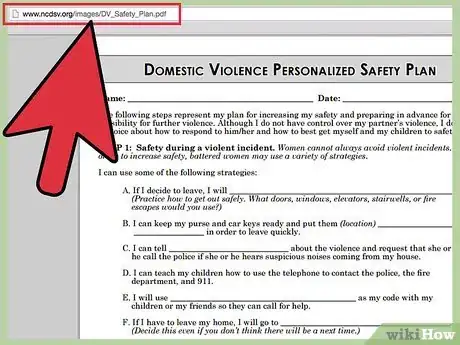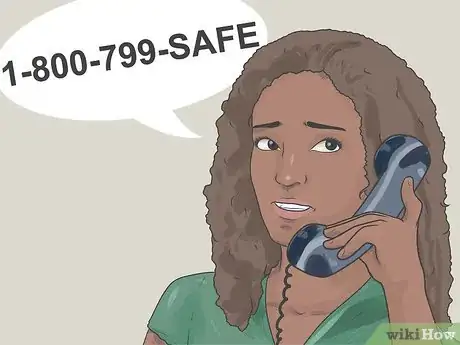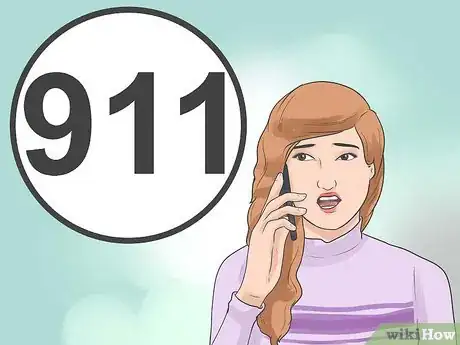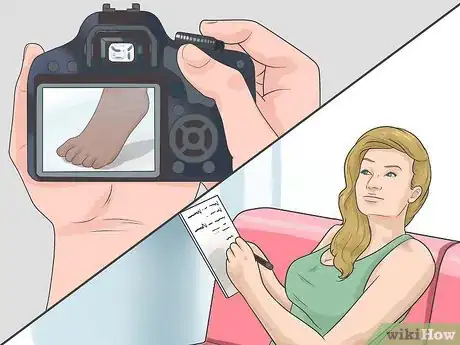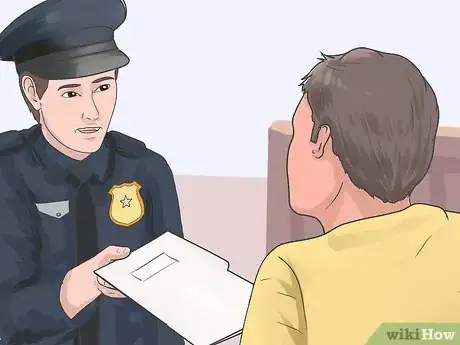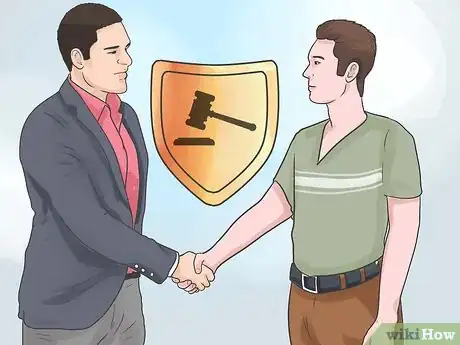This article was co-authored by Saul Jaeger, MS. Saul Jaeger is a Police Officer and Captain of the Mountain View, California Police Department (MVPD). Saul has over 17 years of experience as a patrol officer, field training officer, traffic officer, detective, hostage negotiator, and as the traffic unit’s sergeant and Public Information Officer for the MVPD. At the MVPD, in addition to commanding the Field Operations Division, Saul has also led the Communications Center (dispatch) and the Crisis Negotiation Team. He earned an MS in Emergency Services Management from the California State University, Long Beach in 2008 and a BS in Administration of Justice from the University of Phoenix in 2006. He also earned a Corporate Innovation LEAD Certificate from the Stanford University Graduate School of Business in 2018.
There are 8 references cited in this article, which can be found at the bottom of the page.
This article has been viewed 128,968 times.
Domestic violence is also sometimes known as intimate partner violence or “battering.” It is a pattern of sexual, physical, psychological, and/or emotional abuse used by one partner to gain control over the other.[1] Women are more commonly victims of domestic violence than men, but both can experience domestic violence and abuse.[2] Domestic violence occurs as frequently in LGBTQ+ relationships as in heterosexual relationships. Only about half of domestic violence incidents are reported to authorities. Whether you need to speak up on your own behalf or call on behalf of a loved one, reporting domestic violence is the first step to breaking its power.
If you or someone you know has been the victim of domestic violence, see the Additional Resources section to get in touch with local agencies.
Steps
Reporting Domestic Violence Against Your Perpetrator
-
1Pack an emergency escape bag. Buy a cheap mobile phone, and put all of the people that you need to contact in its memory (friends, family, women's aid numbers, doctors, as well as numbers for your children’s services -- school, pediatrician, etc. -- if you have children). Pack documents that show your ownership of any vehicle or property, as well as passports, and other identity information. Obtain a secondary cash card for your bank and add money to it.
- Pack several changes of clothes. If you have children, pack clothes for them as well.
- If you take prescription medication, pack it as well, along with the prescription information sheets.
- Take the bag to a place where you can retrieve it quickly if you have to run. Do not store it at home; it is best to keep it at the house of a trusted friend. If you must keep it at home, make sure that it is well concealed.
-
2Form a safety plan. The National Center on Domestic and Sexual Violence has a PDF form that will help you develop a plan for what to do if you have to call the authorities. Fill it out and keep a copy in a safe, secure place where your abuser cannot find it.
- Give a copy to a friend as well. This will ensure that your loved ones will know how to support you when you need it.
Advertisement -
3Call a domestic violence hotline.[3] Domestic violence hotlines, such as the National Domestic Violence Hotline (1-800-799-SAFE), can help you prepare to report domestic violence. The trained advocates at these hotlines are experienced in listening to you and offering advice in how to best care for yourself.[4]
- Calls to these hotlines are free and confidential and you will never be judged.
- If your phone or internet use is monitored at home, you can use a computer at a public library to chat with a hotline or call from a friend’s phone. Whatever you do, stay safe.
- These hotlines can also refer you to local women’s advocates and shelters.
-
4Call emergency services.[5] It’s crucial to establish a “paper trail” to help you stay safe from your abuser. Call the police or emergency services like 911. Tell them exactly what has happened, that you do not feel safe, and that it is an emergency.[6] The police are required to arrest suspects under certain domestic situations, which vary by state.
- When the police arrive, give them all the details of what happened. Include the exact actions and words that your abuser used, if you can remember them.
- If you have children, let the police know where they are.
- If you were injured, show the police your injuries or at least describe them.
-
5Document the incident. If you can do so safely, keeping copies of damage or injuries from the incident can help you prove your case in court or obtain a personal protective order.[7]
- Take photos of any visible harm or injury, such as bruises, cuts, torn clothes, etc.
- Write down what was said, as precisely as you can recall it.
- Take photos of damage to property, such as destroyed furniture, holes in walls, etc.
- Make copies of any threatening messages, such as emails, social media messages, or phone calls.
- Get statements from any witnesses to the event, including your children.
-
6Get a copy of the incident report. In most states, the police are required to fill out a “domestic incident report” or other case report. Get a copy of this report as well as your case number.
- Also get the officers’ names and badge numbers. This can be helpful if you need to add information to the report later, or if you need to call witnesses for a court case.
-
7Find a safe shelter. If you have pre-arranged with a friend or family member, go to their house. If you have children, take them with you. You can also search for safehouses and women’s shelters in your area. A domestic violence hotline may be able to refer you to a safe location.
- A “safehouse” is usually a secret location that is accessible 24 hours a day so that you can go there at any time you need. These locations are often run by nonprofit organizations and can usually put you in touch with advocates, counseling services, and legal aid.
-
8Go to the hospital. If you were injured in any way, go to the hospital. This will not only get you treatment for your injuries, it will further establish official documentation of your abuse. This is vital for prosecutors in criminal cases and will help you obtain a protection order.
- Tell the staff about any injuries you experienced. If you feel comfortable doing so, you can say how you got the injuries. Remember, people are there to help you, not to judge you. There’s no need to feel ashamed or embarrassed. You didn’t do anything wrong.
- Be extra vigilant about any injuries to your head. If you experience memory loss, dizziness, eyesight trouble, vomiting, or headache after an abusive incident, go to the hospital right away.
-
9Seek an order of protection. These documents go by several other names, including “personal protection order” and “restraining order.” They are court orders that can help protect you from your abuser, and provide steep penalties for the abuser if s/he attempts to harass you again. They can also help protect your children from the abuser. You must go before the local court (often, the circuit court or county court) to obtain one.[8]
- Many domestic violence agencies offer assistance in applying for protection orders, filing criminal charges, and other legal aid.
- Anyone who has been physically, sexually, emotionally, or psychologically abused by someone they have been in a relationship with (including marriage, dating, living or rooming with, or having a child with) can apply for a protection order.
- Victims of stalking, which is considered another type of domestic violence, may also apply for protection orders.
- Bring a letter explaining your situation in as much detail as possible to the court. Also bring copies of all the documentation that you can, including police reports, photographs, statements, etc. Provide information about your abuser or stalker.
- Carry a copy of your protection order with you at all times. This helps police enforce the terms of the order if anyone attempts to violate it.
Reporting Domestic Violence Against a Loved One
-
1Call the authorities in an emergency.[9] If you hear or see abusive activity that seems immediately threatening, call the police. You can also call the police if at any time you feel afraid for your own safety.
- Be aware that in some cases, the victim of domestic violence may deny or downplay what has happened out of fear of the abuser. Do not blame or become upset with the person if this happens.
- If you don’t want to call the police but you hear abuse happening, you can “drop by” and ask to borrow something to interrupt the violence. Abusers will often not want to show their true behavior to others.
-
2Speak with your loved one first. While it’s natural to want to help, calling the police or authorities to report domestic violence if the person being abused doesn’t have a safety plan in place can actually create more problems. Talk with your loved one about your concerns and their wishes before you do anything.
- Choose a safe place away from the person you suspect of abuse. Don’t mention your concerns in front of the abusive person -- this could put your loved in even greater danger later.
- Be honest and supportive with your concerns. Don’t make accusations or ultimatums.
-
3Offer nonjudgmental support. Many victims of domestic violence don’t leave the abusive situation, and each person may have many reasons not to do so. Don’t criticize your loved one or act as though you “know” what they need to do.[10]
- Believe your loved one. Many abusers tell their victims that nobody will believe them or care for them. Tell your loved one that you believe them and are there for them, no matter what.
- Reassure your loved one that their feelings are normal. It’s common for victims of domestic violence to feel confused, embarrassed, depressed, overwhelmed, or frightened about their situations.
-
4Offer to help develop a safety plan. Your loved one will need a way to assure safety once the domestic violence has been reported. While many states have “mandatory arrest” laws that arrest suspects of domestic violence, many of these abusers are released and take “revenge” on those who reported them. The National Center on Domestic and Sexual Violence has a PDF form that can help you and your loved ones make plans.
- Keep a copy of your loved one’s safety plan at your home. This way you’ll know exactly what you can do to help.
- Agree on a “code word” or signal. Many abusive partners monitor their victims’ communications, even on the internet or cellphones. Come up with a signal that your loved one can use to let you know they're in trouble.
- Keep an emergency bag for your loved one at your home. This should include copies of all important documentation (passports, birth certificates, photo IDs, etc.) as well as several changes of clothes, a prepaid cellphone, money, and any necessary prescription medications.
-
5Contact a domestic violence agency. Understanding what your loved one is going through, and knowing the resources available, will help you provide better support. You can call the National Domestic Violence Hotline at 1-800-799-SAFE for a referral to an agency in your area.
- Domestic violence agencies generally have advocates who can help the abused person get in touch with the authorities, stay safe, and escape the abusive situation.
-
6Remember that you can’t “save” the person. It can be incredibly hard to know that a loved one is the victim of domestic violence and is staying in an abusive situation. However, you have to remember that it is not your place to “save” or “rescue” your loved one. Offer your unconditional support and caring, and let them make their own decisions.
- Victims of domestic abuse often feel disrespected and without any power in their own lives. By showing that you support your loved one and respect their choices, you are giving them something they may not get from anyone else.
Additional Resources
| Organization | Phone Number |
|---|---|
| The National Domestic Violence Hotline |
(800) 799-7233 |
| RAINN |
(800) 656-4673 |
| Childhelp (Child abuse) |
(800) 422-4453 |
Warnings
- You should certainly call the police if you believe someone is in an imminently dangerous situation.⧼thumbs_response⧽
References
- ↑ http://www.cdc.gov/violenceprevention/intimatepartnerviolence/
- ↑ http://www.cdc.gov/mmwr/preview/mmwrhtml/ss6308a1.htm?s_cid=ss6308a1_e
- ↑ Saul Jaeger, MS. Police Captain, Mountain View Police Department. Expert Interview. 21 February 2020.
- ↑ http://www.thehotline.org/help/what-to-expect-when-you-contact-the-hotline/
- ↑ Saul Jaeger, MS. Police Captain, Mountain View Police Department. Expert Interview. 21 February 2020.
- ↑ http://www.opdv.ny.gov/help/fss/policecourts.html
- ↑ http://www.opdv.ny.gov/help/fss/policecourts.html
- ↑ http://www.clarkprosecutor.org/html/domviol/domvic.htm
- ↑ Saul Jaeger, MS. Police Captain, Mountain View Police Department. Expert Interview. 21 February 2020.
About This Article
Dealing with domestic violence can be confusing and scary, but it’s important to report it to protect yourself and other people in the future. If you’re injured, go to the hospital for treatment. If you’re not badly hurt, pack an emergency bag and go to stay with a trusted friend or family member. If you don’t have anyone to stay with, contact a safe shelter, who can help you find accommodation. Then, call the police as soon as you’re safe to do so and tell them exactly what happened. If you have any visible injuries, like bruises, cuts, or torn clothing, take photos of them to use as evidence. The police will help you file a report, which can help you file a restraining order, get a divorce, or prove your story if your partner hurts you again. The more evidence there is of domestic violence, the easier it’ll be to bring your partner to justice. You can also call a confidential domestic violence hotline if you need guidance or a sympathetic ear. For more tips from our co-author, including how to file a restraining order, read on.

